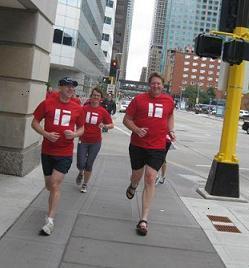Seven Strategic Directions for Engaging Employees Through eHealth
 July 21, 2011
July 21, 2011  RedBrick Health Employees Participating in the Biggest Loser Minnesota ChallengeDuring the Healthcare Unbound conference in San Diego last week, I started our “New Directions in Employee Engagement” panel with an overview of innovative approaches that are emerging.
RedBrick Health Employees Participating in the Biggest Loser Minnesota ChallengeDuring the Healthcare Unbound conference in San Diego last week, I started our “New Directions in Employee Engagement” panel with an overview of innovative approaches that are emerging.
1. Employee Driven. Companies are moving beyond surveys and focus groups, which gather a snap shot of insight, to co-creating with their employees in a private online community. Within their intranet, these employers are enabling their employees to surface new ideas, define new products and programs suggested by co-workers and prioritize where they want their employer to invest their limited health and wellness resources. During the conference panel, Lisa McGill, VP, Worldwide Human Resources from Brocade, discussed their online BHive community where their WellFit Employee Advisory Council innovates on wellness offerings.
2. One Integrated Program on One Platform. Employees struggle every day to keep their job, family and personal life on track. Instead of promoting many separate ways for their employees to pay attention to their health, companies are bringing all their initiatives into a single and integrated program. Employers are tying their health risk assessments, screenings, social challenges and coaching in with their reward program to incentivize their employees. At the same time, they are simplifying the process with an integrated technology platform. With this holistic approach, employers are able to monitor the elements of the program that are driving healthy change while experimenting with new elements such as mobile applications to generate engagement.
3. Customized Approach. “My employees work in a call center and do not have time to attend our onsite wellness sessions but would be interested in watching a webinar for example around stress management”, explains a large technology employer. The key to engaging employees is to understand their lifestyle profile and customize a program that fits into their day and aligns with their technology comfort. Think about how different the Health & Wellness Program may be for a technology firm than a manufacturing company. One size does not fit all.
4. Personalized Experience. Some of the biggest mistakes that employers are making is distributing all of their content to all of their employees or assuming that one area (e.g. walking programs) appeals to all of their employees. More innovative employers are enabling each employee to determine how they want to participate based on their interests and needs. These employers are also letting their employees set their content and communication preferences which guide their multi-channel experience.
5. Influencer Enabling. With the emergence of social health related challenges within a company and the associated online social network to connect teammates, employers are noticing that certain employees are having a positive impact on the health behaviors of others. Employers are starting to arm these influencers with online tools and resources. Some companies are calling them “Wellness Ambassadors” or “Wellness Champions”. Employers that have many different offices with limited budget are leveraging these influencer representatives to generate engagement throughout their company footprint.
6. Social Currency. Employers are letting their employees create social currency by providing a space on the intranet to share. Employees are uploading pictures, videos and writing stories such as how Susan lost 50+ pounds or when Joe participated in his first triathlon. Why is this social currency valuable to employees? It is inspirational, insightful and meaningful since these contributions are from fellow employees with whom they have a common bond. This social sharing is particularly powerful when an employee turns their experience into a mini- challenge to other employees. Bryce Williams, Director of Wellvolution, Blue Shield California mentioned that throughout their 6- week employee social competition, there were “over 1,000 viral wellness challenges”.
7. Family Engagement. “We are trying different approaches to get the spouses to participate in our health programs,” explains a large financial services employer. Employers are extending rewards to the spouses to motivate their participation. This is particularly important since employees make many health and wellness decisions on a daily basis with their spouses and we all know that negative behaviors can be costly. How are employers engaging with families in a positive way? During the panel, Pat Sukhum, Co-founder and Marketing Director at RedBrick Health described their Biggest Loser Challenge which this year was extended to the community and to employee’s families. “One of the largest divisions in Challenge included over 3,400 participants who signed-up as teams of families to compete and improve their health together,” Sukhum noted.
Each of these new directions in employee engagement requires a technology solution to power the capabilities described. Given that each employer and set of employees is different, it is important to determine what is needed and how to tune the solution to deliver the communication, collaboration and challenges to engage employees and their families.




Reader Comments